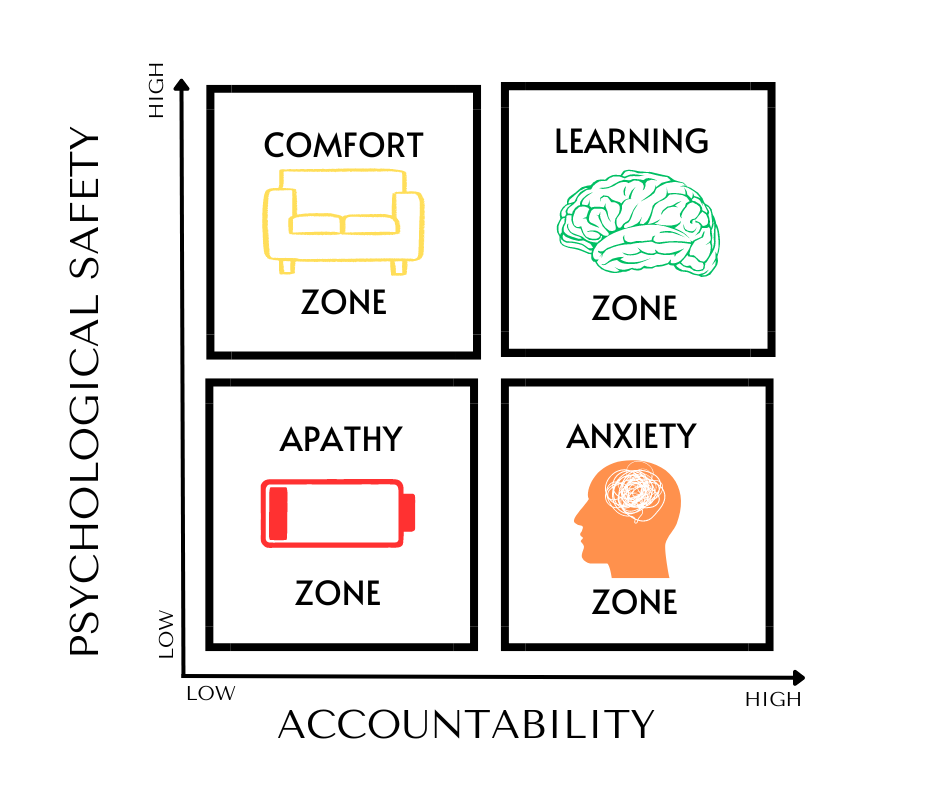Executive Corner – Safe is Nice, But Nice isn’t Always Safe
Michael Clegg | 07/12/2023
Meet Sarah, a Project Manager at a marketing firm. Her boss, Alex, was generally nice and easy to talk to (about non-work-related topics), but highly critical and quick to dismiss ideas that didn’t align with his own. The work environment was tense, with little room for open dialogue regarding projects.
One day, Sarah came up with a creative idea for a new marketing campaign that she believed could greatly benefit one of their clients. She was excited about the concept and its potential impact, but she was very hesitant to share her idea with Alex. She didn’t want to be embarrassed or rejected.
“It wouldn’t matter anyway, our opinions don’t matter to Alex”, she thought.
She dismissed her own idea and went on working on the project the way Alex told her to, but she started to feel frustrated, undervalued, and resentful.
She didn’t understand how he could be so nice, yet so hard to work for. He was friendly and could chat up a storm about almost anything. He kept a positive attitude and avoided conflict—often meaning tit was never addressed properly.
He was just a nice guy.
But nice isn’t always safe—psychologically safe, that is.
This is one of the many misconceptions about psychological safety.
Being a “nice” boss doesn’t mean that you’re being supportive or collaborative. Being “friendly” doesn’t guarantee that your team feels safe approaching you about a conflict they are experiencing.
Creating a psychologically safe environment is much more than just maintaining a positive attitude and being nice.
Psychologically safe environments allow for freedom of expression without any worry about backlash or humiliation. It is your responsibility to ensure that your team members feel comfortable approaching you with their ideas or concerns. They shouldn’t hesitate or second-guess themselves when they have questions or mistakes to share. They shouldn’t have to worry about being embarrassed or punished for voicing their opinion.
Psychological safety is either high or low. You are either fostering an environment where your team is comfortable talking to you and sharing ideas, or they aren’t. Accountability is also either high or low. You’re either holding your team accountable for their tasks and goals, or you aren’t.
So, when you compare the two, you can get (generally), four different outcomes.

Apathy Zone – Psychological safety and accountability are both low. Employees may feel undervalued and unappreciated. They can’t come to you with their concerns, ideas, or opinions, but they also may not care because they don’t think that you care.
Anxiety Zone – Psychological safety is low, but accountability is high. Your team is stressed to the max trying to please you and make you happy, but they aren’t comfortable coming to you with their concerns.
Comfort Zone – Psychological safety is high, but accountability is low. Your team feels comfortable approaching you, but you aren’t holding them accountable for their goals and responsibilities, so they just settle in and get comfortable flying beneath the radar.
Learning Zone – Psychological safety and accountability are both high. This is where you want to be! You’re holding your team accountable, having collaborative and open conversations, and you are addressing their ideas, concerns, and conflicts. Your organization is learning, adapting, and growing.
That sounds simple enough…but how do I get to the learning zone?
First, consider the following questions (and be honest with yourself!):
- Am I open to feedback and actively encourage others to share their thoughts, concerns, and suggestions?
- Am I approachable and accessible to team members, fostering an environment where they feel safe to share their experiences and seek guidance?
- Do I demonstrate empathy and understanding towards team members’ challenges and emotions?
- Do my team members feel comfortable expressing diverse opinions and challenging ideas without fear of negative consequences?
- Are conflicts and disagreements addressed constructively, promoting healthy dialogue and resolution, or are they dismissed or ignored?
- Do I promote collaboration and teamwork, encouraging an inclusive and supportive atmosphere?
If you answered no to most or all of those questions, here are 5 tips to help you make the shift into creating a safe environment.
Treat your employees the way they want to be treated.
Rather than the traditional “treat others how you would like to be treated”, consider how your employees would like to be treated. Create an environment where team members’ individual preferences are valued and respected and keep those in mind when communicating with each of them.
Encourage curiosity and creativity.
Create an environment where you encourage curiosity and creativity as a catalyst for growth. Encouraging a learning mindset and fostering a safe space for asking questions and exploring new ideas leads to overall better communication, alignment, and problem-solving.
Embrace healthy conflict.
I’ve said it many times before, and I will say it again. Conflict is a good thing (when addressed properly). Conflict kickstarts change and growth in your organization. Don’t sweep it under the rug—address it head-on and allow it to help you.
Give your employees a voice.
Allow open brainstorming sessions and encourage them to voice incomplete thoughts, question established norms, share feedback, and work through disagreements together. It is rooted in the belief that leaders value honesty, candor, and truth-telling, and that team members support and protect each other.
Focus on effectiveness over efficiency.
Shift the leadership perspective to prioritize creating a safe and secure environment that nurtures employees’ well-being and unleashes their full potential. By creating a circle of safety, leaders enable individuals to channel their energy into protecting the organization from external threats and embracing opportunities, leading to greater engagement, productivity, and innovation.
Once you’ve incorporated the above into your workplace, you might see a shift in your team’s behavior. There are 4 steps to psychological safety:
- Inclusion Safety: This refers to the extent to which individuals feel valued, respected, and included in the team or organization. It involves creating an environment where diversity is embraced, and all team members feel a sense of belonging. Inclusion safety ensures that everyone’s perspectives and experiences are recognized, appreciated, and considered in decision-making processes, fostering an atmosphere of acceptance and respect.
- Learner Safety: Learner safety pertains to the ability of individuals to take risks, make mistakes, and engage in learning without fear of negative consequences. It involves creating a culture that values continuous learning and improvement. In a psychologically safe environment, team members feel encouraged to ask questions, seek feedback, experiment, and explore new ideas or approaches. Learner safety supports personal and professional growth by removing the fear of failure and promoting a growth mindset.
- Contributor Safety: Contributor safety relates to the freedom of individuals to express their thoughts, opinions, and ideas without the fear of judgment, rejection, or ridicule. It involves creating an environment where all contributions are welcomed and respected. In psychologically safe settings, team members feel comfortable sharing their perspectives, making suggestions, and offering their unique insights. Contributor safety encourages active participation and engagement, fostering a sense of empowerment and ownership within the team.
- Challenge Safety: Challenge safety refers to the openness to constructive disagreement, healthy debate, and the exploration of alternative viewpoints. It involves creating an atmosphere where individuals can challenge existing ideas, assumptions, and practices without fear of negative repercussions. In a psychologically safe environment, team members can engage in respectful and constructive conflicts, promoting critical thinking, innovation, and improved decision-making. Challenge safety encourages intellectual discourse and helps avoid groupthink or complacency.
These dimensions of psychological safety work together to create an environment where individuals feel supported, valued, and empowered to contribute their best work. By fostering psychological safety in your organization, you can lead a more productive team that promotes a culture of trust, collaboration, and continuous growth.
Sources: HBR Jostle Center for Creative Leadership The Growth Faculty Slido
Want more leadership-focused content?




